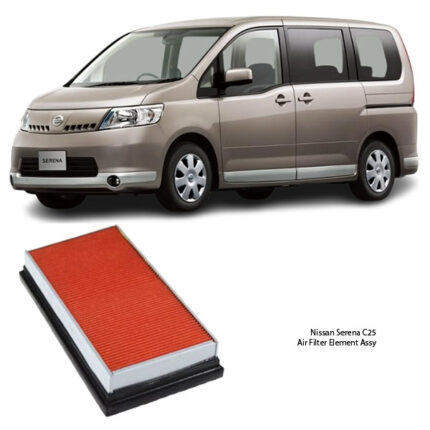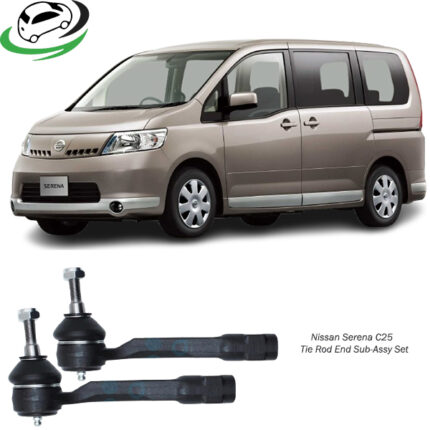-25%
Get Nissan Serena C25 Front Stabilizer Link SL-N220 in Kenya
The front stabilizer link, often referred to as the sway bar link or anti-roll bar link, is a small but crucial part of a vehicle’s suspension system. It plays a significant role in improving stability, reducing body roll, and enhancing handling. Positioned on the front suspension of the vehicle, it connects the sway bar (stabilizer bar) to the suspension struts or control arms, enabling the sway bar to perform its function effectively. Understanding the front stabilizer link’s design, function, maintenance requirements, and common issues can provide insights into its importance in vehicle performance and passenger safety.
1. Structure and Components of the Front Stabilizer Link
The front stabilizer link is relatively simple in structure but vital in functionality. It generally consists of the following components:
- Link Rod: The primary component that connects the sway bar to the suspension. This rod can be a solid or hollow bar made of materials like steel, aluminum, or composite alloys for strength and durability.
- Ball Joints or Bushings: At both ends of the link rod are ball joints or bushings that allow flexibility. Ball joints enable rotation and pivoting, accommodating changes in the angle between the sway bar and the suspension. In some designs, bushings (made from rubber or polyurethane) dampen vibrations and reduce noise.
- Mounting Hardware: Nuts, bolts, and washers are used to secure the link to both the sway bar and suspension component. They keep the stabilizer link firmly in place and withstand the stresses of suspension movement and vibrations.
The front stabilizer link has two placements — one on the left and one on the right side of the vehicle. These symmetrical parts work in tandem to stabilize the vehicle, especially when turning or driving on uneven surfaces.
2. Function of the Front Stabilizer Link
The front stabilizer link serves as the crucial connection point between the stabilizer bar and the vehicle’s suspension system, enabling the stabilizer bar to perform its role in maintaining vehicle balance and stability. Here’s how the stabilizer link functions:
a. Connecting the Sway Bar to the Suspension
The stabilizer link physically connects the sway bar to suspension components like control arms or struts. When the vehicle encounters rough terrain or sharp turns, this connection allows the sway bar to transfer force between the suspension on each side of the vehicle, helping balance the load across the wheels.
b. Reducing Body Roll
When a vehicle takes a turn, the centrifugal force causes the vehicle’s body to lean outward, a phenomenon known as body roll. The stabilizer link, by connecting the sway bar to the suspension, helps counter this tilt. It transmits force to the opposite side of the vehicle, reducing the lean and keeping the vehicle level.
c. Enhancing Vehicle Stability and Handling
The stabilizer link enables the sway bar to distribute forces evenly between the left and right suspension systems. This load balancing helps the tires maintain optimal contact with the road, which improves traction, handling, and vehicle stability, especially during high-speed maneuvers or when driving on winding roads.
d. Minimizing Suspension Wear
By distributing loads across both sides of the suspension, the stabilizer link reduces strain on individual suspension components, such as control arms and shock absorbers. This helps extend the lifespan of suspension parts, reducing the likelihood of premature wear and the need for repairs.
3. Benefits of a Functional Front Stabilizer Link
A well-maintained stabilizer link significantly contributes to a safe and smooth driving experience. Some of the major benefits include:
a. Improved Handling and Control
A functional stabilizer link ensures that the sway bar can effectively reduce body roll, keeping the vehicle stable during turns. This makes it easier for the driver to maintain control, particularly in emergency maneuvers or when navigating sharp corners.
b. Increased Comfort for Passengers
By reducing body roll, the stabilizer link provides a smoother ride, which enhances passenger comfort. The vehicle remains more level, giving a secure and balanced feeling even on curvy roads.
c. Enhanced Traction and Safety
With reduced body roll, the tires maintain better contact with the road surface, improving traction. This additional grip enhances overall vehicle safety, particularly in wet or slippery conditions where maintaining tire contact is crucial.
d. Extended Lifespan of Tires and Suspension Components
The stabilizer link helps distribute forces evenly across the suspension system. By reducing excessive loads on any one side, it minimizes uneven tire wear and extends the life of tires, ball joints, bushings, and other suspension parts.
4. Common Issues and Signs of Wear in the Front Stabilizer Link
Over time, the stabilizer link can experience wear and tear due to constant movement, exposure to road conditions, and regular driving stresses. Some common issues include:
a. Worn Ball Joints or Bushings
The ball joints or bushings at the ends of the stabilizer link allow movement but can wear down over time. This wear leads to looseness in the link, compromising the connection between the sway bar and suspension. Signs of worn joints or bushings include clunking noises, increased body roll, and reduced handling stability.
b. Damaged or Broken Link Rod
The link rod may be subjected to physical damage, such as bending or breaking, from impacts with debris or rough roads. A damaged or broken rod affects the link’s ability to transmit force effectively, leading to poor handling.
c. Corrosion and Rust
In regions where road salt is used, rust and corrosion can affect the stabilizer link’s metal components. Corrosion weakens the structure of the link, eventually leading to failure if not addressed.
d. Loose or Corroded Mounting Hardware
The nuts and bolts that secure the stabilizer link can loosen over time, especially if the vehicle travels over rough or bumpy roads frequently. Corroded or loose hardware reduces the stability of the link, impacting the sway bar’s performance.
e. Excessive Movement or Noise
If the stabilizer link becomes worn or loose, it may produce clunking or rattling noises, particularly when driving over bumps or uneven surfaces. Increased body roll and difficulty in controlling the vehicle may also occur.
5. Maintenance and Replacement Tips for Front Stabilizer Links
To maintain optimal performance, the front stabilizer link should be checked regularly, especially if any symptoms of wear or damage appear. Here are some essential maintenance tips:
a. Regular Inspections
During routine maintenance, inspect the stabilizer link for signs of wear, damage, or looseness. Checking for play in the ball joints and any visible rust or corrosion helps identify potential issues early.
b. Replace Worn or Damaged Ball Joints and Bushings
If the ball joints or bushings show signs of wear, replace them promptly to prevent handling issues. Worn bushings or joints reduce the stabilizer link’s effectiveness and can lead to a more significant suspension failure if left unaddressed.
c. Tighten Loose Bolts and Hardware
Regularly check the bolts and nuts securing the stabilizer link. Tightening loose hardware prevents the link from rattling or causing instability.
d. Apply Anti-Rust Treatments
In areas with high exposure to road salt or moisture, applying anti-rust treatments to the stabilizer link can extend its lifespan by preventing corrosion.
e. Replace as a Pair
If one stabilizer link needs replacement, it’s often best to replace both the left and right links at the same time. This ensures even handling characteristics and performance on both sides of the vehicle.
6. Symptoms of a Failing Front Stabilizer Link
Recognizing the signs of a failing stabilizer link helps drivers address the issue before it leads to bigger problems. Here are common symptoms:
- Clunking or Rattling Noise: A worn stabilizer link often makes clunking or rattling sounds, especially over bumps or during turns.
- Increased Body Roll: A failing stabilizer link causes excessive body roll when turning, making the vehicle feel less stable.
- Loose or Unresponsive Steering: If the stabilizer link is worn, it affects the steering response, making the vehicle feel loose or unstable.
- Uneven Tire Wear: Failure in the stabilizer link can lead to uneven tire wear as the suspension system struggles to distribute loads effectively.
Conclusion
The front stabilizer link is a crucial suspension component that helps maintain vehicle stability, improves handling, and reduces body roll. By connecting the sway bar to the suspension, it allows the sway bar to distribute loads evenly between the left and right wheels, enhancing traction and ride comfort. Proper maintenance of the stabilizer link, including regular inspection, tightening of bolts, and prompt replacement of worn components, ensures the link can continue to function effectively. Recognizing symptoms of wear, such as clunking noises and increased body roll, allows drivers to address potential issues early, promoting a safer and smoother driving experience.
Follow us on Facebook for more parts.



